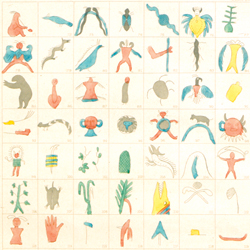
The Illinois River Valley was once ruled by a confederation of Native American tribes, rich in lore and ancient history.
Hieroglyphics, archaeological findings and tribal lore all point to a native people who existed in North America long before Columbus or any other European discovered the New World. Yet due to its constantly changing culture over many centuries, Native American history is very difficult to trace. Much of the history that survives has been handed down through generations of oral stories told by honored elders to their children. But when many tribes from many different places tell the same story, there is value—and a history lesson to learn.
Piecing Together History
In the Midwest, most tribes tell similar tales of their ancestors’ origins. They were known to be highly mobile, following herds of bison across meadows, valleys and plains, and settling near bodies of water where fish, fowl and game were plentiful. They spoke the same basic language, traded with one another, engaged in intertribal conflicts, often acted as peacemakers, and usually came together in mutual time of need.
While they shared many common bonds, these tribes were also quite different from one another. Not all hunters fished; not all fishers hunted. Some tribes were introduced to agriculture and established seasonal homes; some became extinct. Many small groups came together to form larger, more powerful bands, while some large groups splintered to form new sub-tribes. It was a large, ever-changing, complicated, society.
The Algonkin Nation, or Algonquin, appears to be the largest known group to have assembled on the northern shores of Lake Michigan. Its influence stretched across much of the modern United States, with more than 200 tribes and sub-tribes. Though the Algonkin were dispersed across the country, all were bonded by a common language, passing down their tribal legends and customs through stories told over hundreds of years.
For thousands of years, Native Americans have inhabited the Illinois River Valley. By the middle of the 17th century, when Father Jacques Marquette and Louis Joliet were surveying the region, various descendants of the Algonkin, including the Peoria Tribe, which was part of the Illinois Confederation, lived in what is now Peoria County—which at one time extended all the way to the Wisconsin border. Numerous reports by Marquette detailed his interactions with the native peoples he encountered, claiming they were not hostile to the French explorers.
Ravages of the White Man
While recorded information of the early history of Native American tribes is scant, what is well-documented is the involuntary mass migration of native peoples during the 19th century. Though the Illinois tribes joined the French in fighting the British during the French and Indian War, it was ultimately forced to surrender its homeland—first to the British, and then to those who took control from the Crown following the American Revolution.
Signed by President Andrew Jackson in 1830, the Indian Removal Act forced many of the Great Lakes tribes westward into unsettled lands in Missouri and along the eastern borders of present-day Kansas and Oklahoma. Many of those who escaped compulsory removal fled to Canada, where their descendants remain today. Additional treaties in 1818 and 1832 forced the Peoria Tribe to cede its land in Illinois, as well as territory in Missouri, before it was relocated to Indian Territory in southeastern Kansas near the Osage River, where it united with other banished tribes, like the Kaskaskia, Cahokia, Moingwena, Michigamea, Tamaroa and Pepikokia.
In 1854, the Peoria joined with the Kaskaskia, Wea and Piankashaw to form a confederation for mutual benefit and support. This alliance of tribes, which included descendants of the great mound builders, was known as the Confederated Peoria. In 1867, the Omnibus Treaty forced the confederation to sell its land in Kansas and move to a tract of land in northeastern Oklahoma. In 1939, the tribes adopted a constitution and became known as the Peoria Tribe of Indians of Oklahoma. Today, the Peoria Tribe is one of eight Great Lakes tribes living in northeastern Oklahoma among the flora and fauna in the foothills of the Ozark Mountains.
Through years of war and other hardships, the lives of the American Indians have been greatly impacted by the actions of others. Intertribal conflicts, war, disease and the explosion of European settlers severely weakened the tribes. The seizure of millions of acres of hunting and planting ground through government treaties and forced tribal mergers heightened the death knell. But the taking of their homelands, combined with the forced march of entire tribes to a wild and unruly land, inflicted the most damage—nearly extinguishing the native peoples that had claimed America as their home for thousands of years. iBi

